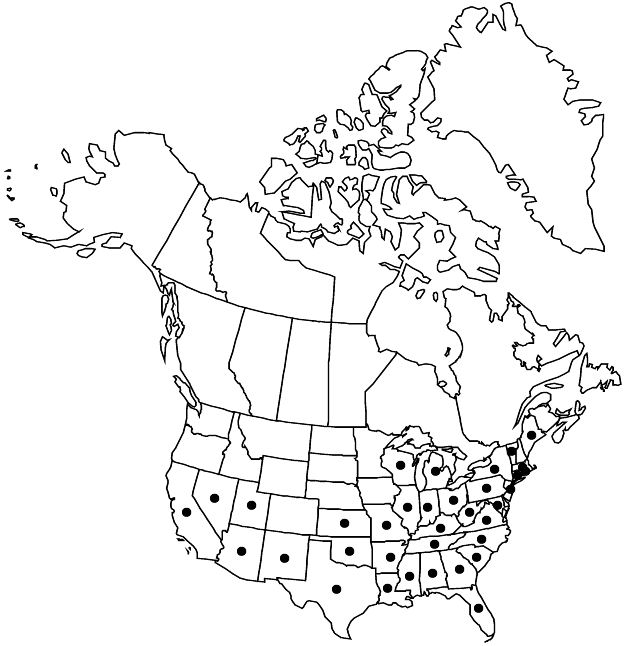Difference between revisions of "Citrullus lanatus"
Index Seminum (Tokyo) 30, no. 854. 1916.
FNA>Volume Importer |
imported>Volume Importer |
||
| Line 33: | Line 33: | ||
-->{{Treatment/Body | -->{{Treatment/Body | ||
| − | |distribution=Asia;Africa;introduced widely. | + | |distribution=Ala.;Ariz.;Ark.;Calif.;Conn.;Fla.;Ga.;Ill.;Ind.;Kans.;Ky.;La.;Maine;Mass.;Md.;Mich.;Miss.;Mo.;N.C.;N.J.;N.Mex.;N.Y.;Nev.;Ohio;Okla.;Pa.;R.I.;S.C.;Tenn.;Tex.;Utah;Va.;Vt.;W.Va.;Wis.;Asia;Africa;introduced widely. |
|discussion=<p>Subspecies 2 (1 in the flora).</p><!-- | |discussion=<p>Subspecies 2 (1 in the flora).</p><!-- | ||
--><p>Subspecies mucosospermus Fursa comprises wild, semicultivated, and cultivated forms in western Africa, including the egusi melon, which is cultivated primarily for its oil and protein-rich seeds. Both subspecies have the same cpDNA haplotype (F. Dane and P. Lang 2004).</p><!-- | --><p>Subspecies mucosospermus Fursa comprises wild, semicultivated, and cultivated forms in western Africa, including the egusi melon, which is cultivated primarily for its oil and protein-rich seeds. Both subspecies have the same cpDNA haplotype (F. Dane and P. Lang 2004).</p><!-- | ||
| Line 53: | Line 53: | ||
|basionyms=Momordica lanata | |basionyms=Momordica lanata | ||
|family=Cucurbitaceae | |family=Cucurbitaceae | ||
| − | |distribution=Asia;Africa;introduced widely. | + | |distribution=Ala.;Ariz.;Ark.;Calif.;Conn.;Fla.;Ga.;Ill.;Ind.;Kans.;Ky.;La.;Maine;Mass.;Md.;Mich.;Miss.;Mo.;N.C.;N.J.;N.Mex.;N.Y.;Nev.;Ohio;Okla.;Pa.;R.I.;S.C.;Tenn.;Tex.;Utah;Va.;Vt.;W.Va.;Wis.;Asia;Africa;introduced widely. |
| − | |||
|reference=None | |reference=None | ||
|publication title=Index Seminum (Tokyo) | |publication title=Index Seminum (Tokyo) | ||
|publication year=1916 | |publication year=1916 | ||
|special status=Illustrated;Introduced | |special status=Illustrated;Introduced | ||
| − | |source xml=https:// | + | |source xml=https://bibilujan@bitbucket.org/aafc-mbb/fna-data-curation.git/src/bb6b7e3a7de7d3b7888a1ad48c7fd8f5c722d8d6/coarse_grained_fna_xml/V6/V6_68.xml |
|genus=Citrullus | |genus=Citrullus | ||
|species=Citrullus lanatus | |species=Citrullus lanatus | ||
Revision as of 23:42, 27 May 2020
Distribution

Ala., Ariz., Ark., Calif., Conn., Fla., Ga., Ill., Ind., Kans., Ky., La., Maine, Mass., Md., Mich., Miss., Mo., N.C., N.J., N.Mex., N.Y., Nev., Ohio, Okla., Pa., R.I., S.C., Tenn., Tex., Utah, Va., Vt., W.Va., Wis., Asia, Africa, introduced widely.
Discussion
Subspecies 2 (1 in the flora).
Subspecies mucosospermus Fursa comprises wild, semicultivated, and cultivated forms in western Africa, including the egusi melon, which is cultivated primarily for its oil and protein-rich seeds. Both subspecies have the same cpDNA haplotype (F. Dane and P. Lang 2004).
Citrullus lanatus generally has been regarded to include the citron melon, commonly as var. citroides; the latter is treated here as 3. Citrullus caffer.
More than a thousand cultivars of Citrullus lanatus have been developed, ranging greatly in shape and size,
from less than a pound to more than 200 pounds, with flesh red, orange, yellow, or greenish. Seedless fruits are from triploid plants produced as hybrids between normal diploids and artificially produced tetraploids. The triploids have sterile pollen and because pollination is required to induce fruit set and enlargement, they must be interplanted with pollenizer diploids.
Selected References
None.